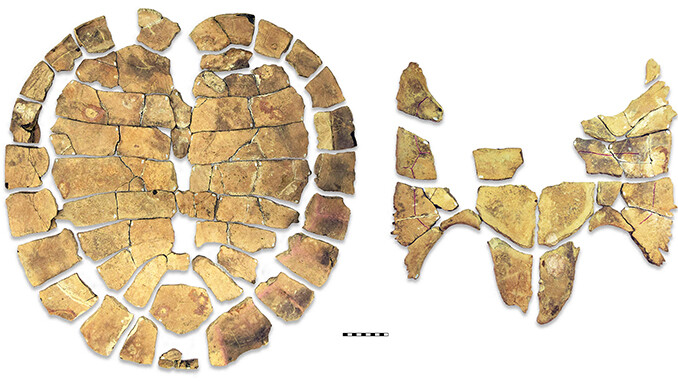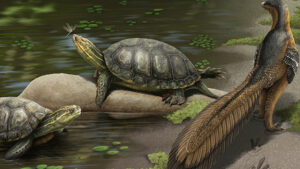On August 19, a team of scientists announced the discovery of a new species of freshwater turtle that lived alongside the dinosaurs, 83-million-years-ago. The scientists who made this discovery are Dr. Andrew D. Gentry of the Alabama School of Mathematics and Science, Mobile, AL, USA, Dr. James F. Parham of the University of California Fullerton, USA, and Caitlin Kiernan of McWane Science Center in Birmingham, AL, USA.
The official name of the new turtle is Appalachemys ebersolei in honor of Alabama paleontologist Jun Ebersole. The fossilized remains were originally found in southern Alabama during the mid-1980’s and held in the collection at the Alabama Museum of Natural History in Tuscaloosa, AL for more than 30 years before being recognized as significant by Parham, the museum’s former curator. “I was aware of the specimen for more than a year after becoming curator but never examined it closely because it was mislabeled as a common species,” says Parham. “When I finally opened the cabinet where it was stored, I knew immediately that it was important. I’ll never forget that moment,” he says.
The study revealed that Appalachemys was a member of a poorly known group of fossil turtles known as macrobaenids which inhabited the rivers and estuaries of North America and Asia roughly 95-55 million years ago. At nearly a meter long, Appalachemys was one of the largest freshwater turtles to ever live in North America. “The size of the animal is really astonishing,” says Gentry.

“We’ve known for quite some time that sea turtles reached immense proportions during the Cretaceous but generally freshwater turtles were, and still are, much smaller.”
Researchers think Appalachemys’ massive size may have evolved due to a combination of the tropical climate in Alabama during that time and as a means of avoiding predation. “There was certainly no shortage of large predators in Alabama during the Cretaceous,” said Gentry. Giant crocodiles, carnivorous dinosaurs, and mosasaurs were all predators that Appalachemys would have had to contend with. “Having a thick shell and being as big as possible would have been helpful but it’s impossible to say if predation was the reason Appalachemys got so big.”
Appalachemys is the latest in a growing list of new species identified from Alabama museum collections in the past decade.
The study, titled “A large non-marine turtle from the Upper Cretaceous of Alabama and a review of North American Macrobaenids,” was published August 19 in the journal Anatomical Record and can be viewed online here: The Anatomical Record – Wiley Online: https://anatomypubs.onlinelibrary.wiley.com/journal/19328494.





